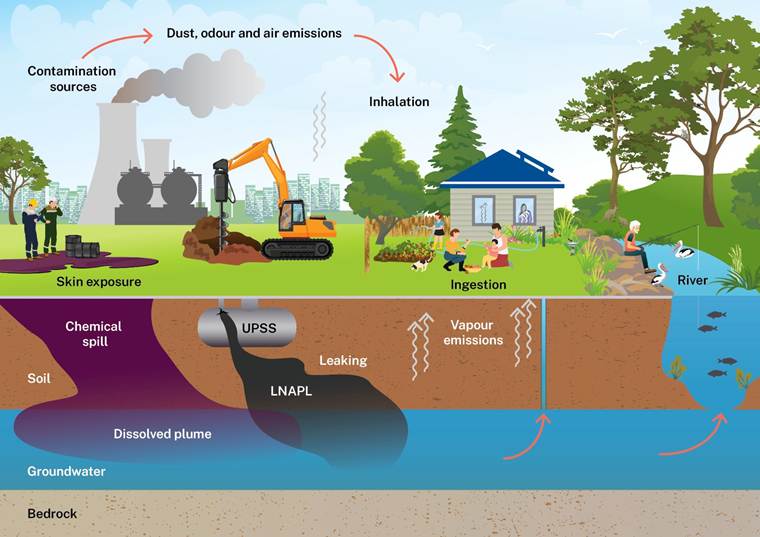Background & Context
- Legislative framework: Notified under the Environment Protection Act, 1986 to fill the legal gap in remediation of chemically contaminated sites.
- Previous status: India had identification and guidance documents (post-2010), but no binding legal procedure for cleanup of contaminated sites.
- Scale of the problem:
- 103 sites identified across India by the Central Pollution Control Board (CPCB).
- Only 7 sites have ongoing remediation work.
- Many sites date back to periods without hazardous waste management regulations.
Relevance : GS 2(Health), GS 3(Environment and Ecology , Science and Technology)

Definition of Contaminated Sites
- As per CPCB: Locations where hazardous and other wastes were historically dumped, causing soil, groundwater, and/or surface water contamination.
- Health & environmental risk: Exposure can lead to cancer, organ damage, reproductive issues, biodiversity loss, and ecosystem degradation.
- Typical examples:
- Old landfills and dumps
- Waste storage/treatment sites
- Spill sites (industrial accidents)
- Chemical waste handling/storage facilities
Causes & Challenges
- Historical dumping: Before hazardous waste rules existed (notably before Hazardous Waste Management Rules, 1989).
- Polluters shut down: Many responsible entities have closed operations or lack financial capacity for cleanup.
- Complex contamination: Requires expensive, technologically advanced remediation (soil washing, bioremediation, pump-and-treat systems).
Evolution of the Legal Framework
- 2010: Capacity Building Program for Industrial Pollution Management Project launched.
- Tasks:
- Inventory of probable contaminated sites – Completed.
- Guidance document for site assessment and remediation – Completed.
- Legal, institutional, and financial framework – Pending till 2025.
- Tasks:
- July 25, 2025: Rules notified to operationalise Step 3.
Key Provisions of the Rules (2025)
a. Identification & Reporting
- District administration:
- Prepares half-yearly reports on “suspected contaminated sites.”
- State Pollution Control Board (SPCB) or reference organisation:
- Conducts preliminary assessment within 90 days.
- Conducts detailed survey within next 90 days to confirm contamination.
b. Assessment Process
- Measures levels of 189 hazardous chemicals (as per Hazardous & Other Wastes Rules, 2016).
- If exceeding safe levels:
- Public notification of location.
- Restrictions on access to the site.
c. Remediation
- Reference organisation: Drafts a remediation plan.
- SPCB: Identifies polluter within 90 days.
- Polluter pays principle: Responsible parties bear cleanup cost.
- If no polluter or inability to pay → Centre/State fund remediation.
d. Liability
- Civil liability: Cost recovery from polluter.
- Criminal liability: If contamination caused death/injury → Punishable under Bharatiya Nyaya Sanhita (BNS), 2023.
Exemptions from the Rules
- Radioactive waste contamination → governed by Atomic Energy Act, 1962.
- Mining-related contamination → covered under Mines & Minerals (Development & Regulation) Act, 1957.
- Marine oil pollution → under Merchant Shipping Act, 1958.
- Solid waste from dump sites → regulated under Solid Waste Management Rules, 2016.
Notable Omissions & Limitations
- No fixed remediation timeline: Risk of indefinite delays after identification.
- Funding ambiguity: No dedicated national remediation fund announced.
- Technology readiness gap: India’s remediation industry is underdeveloped; dependence on foreign expertise likely.
- Overlap with other laws: Potential jurisdictional conflicts with waste, mining, and maritime laws.
Broader Significance
- Environmental governance milestone: First structured, legalised process for contaminated site remediation in India.
- Public health protection: Addresses cancer-causing and toxic chemical exposures.
- Polluter pays enforcement: Strengthens liability culture in environmental law.
- Alignment with global norms: Moves India closer to US Superfund model (Comprehensive Environmental Response, Compensation, and Liability Act – CERCLA).



